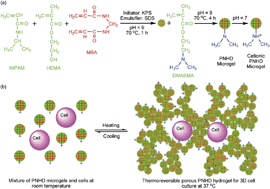A thermally responsive cationic nanogel-based platform for three-dimensional cell culture and recovery†
Abstract
Thermo-sensitive nanogels have attracted great interest due to their versatile biological applications, but little research has been carried out to study their abilities in three-dimensional (3D) cell culture and recovery. A new insight is reported into exploring a low-charged thermosensitive cationic nanogel, poly(N-isopropylacrylamide-co-2-hydroxyethyl methacrylate-co-2-dimethylaminoethyl methacrylate) (P(NIPAM-HEMA-DMAEMA) or PNHD), for 3D cell culture. The positively charged DMAEMA moieties of the PNHD nanogels facilitate cellular attachment, and the low charge density renders those nanogels minimally cytotoxic. The volume phase transition temperatures (VPTTs) of the synthesized PNHD nanogels can be tailored by adjusting monomer feeds during the course of polymerization. Dynamic rheological measurements confirm the fully reversible sol–gel transition for 50 mg mL−1 PNHD nanogels. At room temperature, PNHD nanogels are in their dispersion states, allowing them to be thoroughly mixed with inoculated cells. Above their gelation temperatures, hydrogels containing a mixture of cells and nanogels are formed in situ. The increase in viable cells with culture time suggests that the in situ formed hydrogels support cell proliferation. Recovery of these cultured cells can be simply achieved by cooling the mixed hydrogels below their gelation temperature. The spherical shape of the released cells indicates their 3D growth in the absence of a physical scaffold. The released cells are not only alive, but also retain the capability of migration.


 Please wait while we load your content...
Please wait while we load your content...